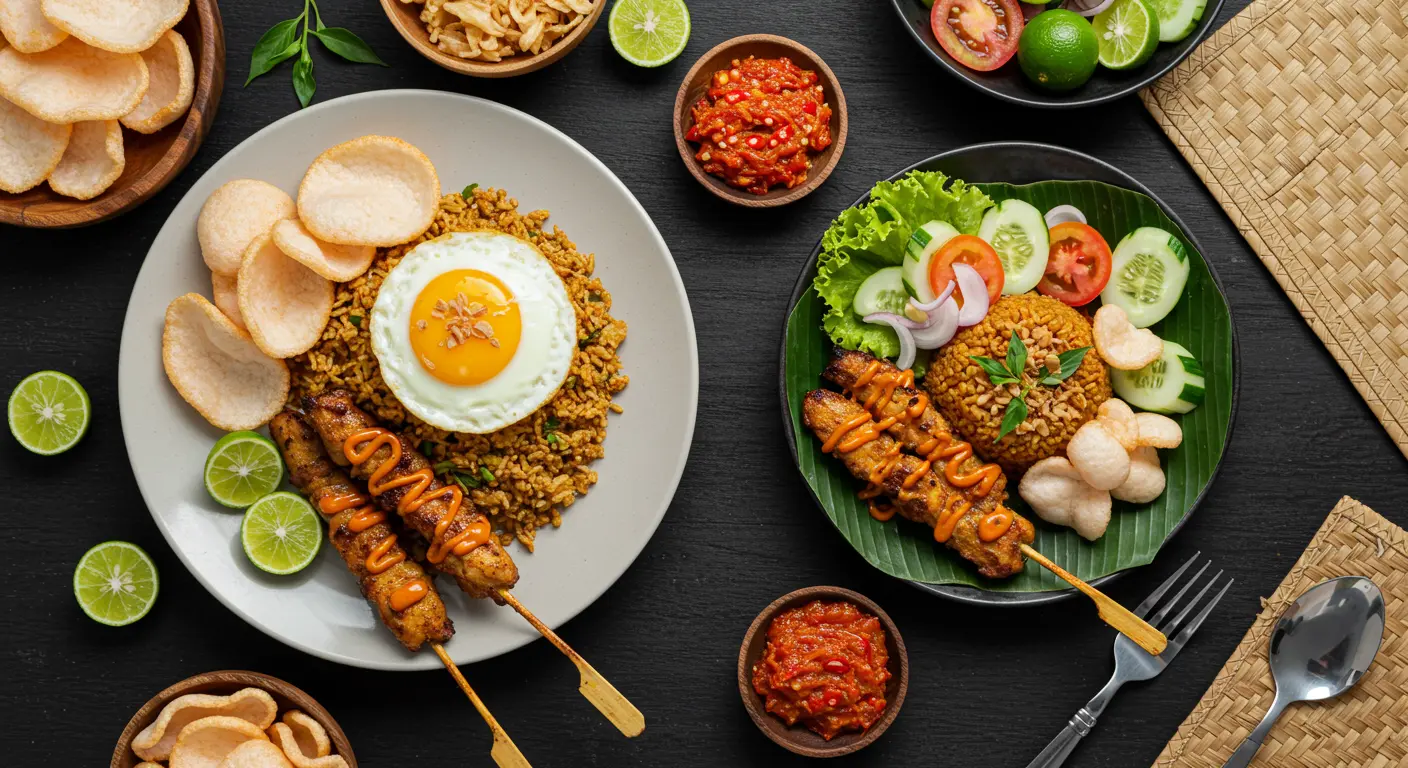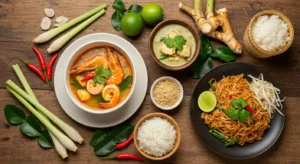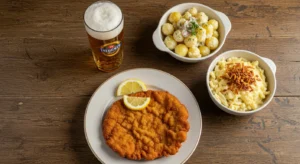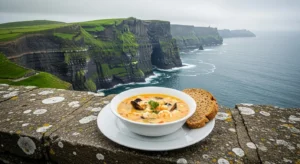Table of Contents
Indonesian Food: Your Flavor-Packed Passport to the Islands
You know that feeling when a single bite transports you somewhere completely new? The air is thick with the scent of lemongrass and sizzling spices. The sound of a bustling night market hums in the background. That first taste is a revelation little sweet, a bold kick of heat, and a deep, savory richness that makes you pause. That is the magic of Indonesian food.
For many beginners, the world’s fourth-most-populous country can seem like a culinary maze. With over 17,000 islands and hundreds of ethnic groups, where do you even begin? It’s easy to feel overwhelmed, to stick with the one satay skewer you know and call it a day. But I’m here to tell you that unlocking the joys of Indonesian cuisine is easier and far more rewarding than you think.
This guide is your friendly map. We’ll ditch the intimidation and dive into the heart of what makes this cuisine so special. We’ll explore the key flavors that form its foundation, highlight the essential dishes you need to try, and even give you the confidence to navigate a local restaurant menu. Get ready; your taste buds are in for an adventure.
The Soul of the Kitchen: Understanding Indonesia’s “Holy Trinity”
Before we talk about specific dishes, let’s talk about flavor. Indonesian cooking isn’t built on a single superstar ingredient but on a harmonious blend of fundamentals. If I had to pinpoint the soul of the kitchen, it would be this trio:
- Bumbu: This isn’t just a word for “spices.” Bumbu refers to the complex, aromatic paste that forms the base of countless dishes. It’s almost always freshly ground using a mortar and pestle (cobek). A typical bumbu might include shallots, garlic, ginger, turmeric, galangal (a sharper cousin of ginger), and chilies. This paste is slowly sautéed in oil until it’s incredibly fragrant, creating a foundation of deep, toasty flavor.
- Kecap Manis: Forget what you know about thin, salty soy sauce. Indonesia’s kecap manis is a game-changer. It’s a thick, syrupy, sweet soy sauce made by fermenting soybeans and blending them with palm sugar and spices. It’s the ingredient that gives dishes like nasi goreng their characteristic glossy, sweet-salty depth. It’s a staple marinade and finishing glaze.
- Sambal: Let’s be clear: Sambal is life. It’s a catch-all term for chili-based condiments that range from freshly ground and bright to fermented and funky. No Indonesian table is complete without at least one type of sambal. It’s not just about heat; it’s about adding a burst of acidity, saltiness, and umami that customizes every bite. A meal just doesn’t feel complete without it.
Your “Must-Try” Starter Pack: 5 Indonesian Dishes You Can’t Miss
Okay, enough theory. Let’s get to the good stuff. Here are five iconic dishes that serve as the perfect introduction. Think of this as your culinary starter pack.
1. Nasi Goreng: The National Treasure
If you only try one dish, make it Nasi Goreng. Translating simply to “fried rice,” this is Indonesia’s ultimate comfort food. But it’s so much more than leftovers tossed in a pan.
The magic lies in the bumbu and the kecap manis. The rice is fried with a savory-sweet paste, often including shrimp paste (terasi) for an umami punch. It’s typically topped with a fried egg with a runny yolk, crispy shallots, and a skewer of satay or some prawn crackers (krupuk). It’s a perfect, balanced meal in one plate: salty, sweet, savory, and a little smoky. It’s the dish that made me fall in love with Indonesian cooking during my first visit to Jakarta.
2. Satay: The World-Famous Street Food
You’ve probably seen these skewers before. Sate (as it’s spelled locally) consists of marinated, grilled meat on a bamboo stick. But the real star is the sauce. While peanut sauce is the most famous internationally, regional variations abound.
The meat, often chicken, goat, or beef, is marinated in turmeric and other spices before hitting the grill, giving it a beautiful golden color and smoky flavor. It’s then drenched in a rich, slightly sweet, and savory peanut sauce. The combination of smoky meat and creamy, nutty sauce is utterly irresistible. It’s the quintessential Indonesian street food experience.
3. Gado-Gado: The Vibrant “Salad” for Everyone
Don’t let the term “salad” fool you. Gado-Gado is a hearty, cooked vegetable salad that’s a meal in itself. It’s a fantastic option for vegetarians and a brilliant way to experience Indonesian flavors without the meat.
A typical plate is a colorful mosaic of blanched spinach, green beans, bean sprouts, potatoes, hard-boiled eggs, tofu, and tempeh, all drenched in that same glorious peanut sauce used for satay. But here, the sauce is often thinner and more tangy, acting as a dressing that brings all the elements together. It’s fresh, satisfying, and packed with texture.
4. Rendang: The “World’s Best” Beef Dish
You might have heard the hype. In 2011, Rendang was voted the number one dish in CNN Travel’s “World’s 50 Best Foods” list. And it earns every bit of that praise. Hailing from West Sumatra, this isn’t a quick curry.
Rendang is a labor of love. Beef is slowly simmered for hours in a rich concoction of coconut milk and a complex paste of ginger, galangal, turmeric, lemongrass, and chilies. The liquid gradually reduces, allowing the meat to absorb all the spices before it’s finally caramelized and fried in the coconut oil that separates out. The result? Incredibly tender, dark, and intensely flavorful beef that’s simultaneously spicy, sweet, and aromatic. It’s a dish that requires patience and expertise, often reserved for special occasions.
5. Soto Ayam: The Cure-All Chicken Soup
Every culture has its comforting soup, and in Indonesia, Soto Ayam is it. This fragrant chicken soup is a breakfast staple, a pick-me-up, and a cure for the common cold.
What sets it apart is its vibrant yellow broth, colored by fresh turmeric. The base is a clear, aromatic stock infused with lemongrass, galangal, and lime leaves. It’s filled with shredded chicken, vermicelli noodles, and hard-boiled eggs, and then garnished with a confetti of crispy fried shallots and celery leaves. You squeeze a wedge of lime over the top just before eating, which brightens the entire bowl. It’s the ultimate comfort food—healing, light, yet deeply satisfying.
Beyond the Plate: A Quick Guide to Dining Etiquette
Part of the experience is knowing how to enjoy the meal like a local. Here are a few quick tips:
- The Right Hand Rule: Traditionally, food is eaten with the right hand. It’s considered more polite. While cutlery (a spoon and fork) is common now, don’t be surprised to see people using their hands, especially for dishes like nasi goreng or ayam goreng (fried chicken). The left hand is typically reserved for, well, less savory tasks.
- Sharing is Caring: Meals are often communal. Several dishes will be placed in the center of the table for everyone to share. It’s a wonderful way to try a little bit of everything.
- Say “Terima Kasih”: A simple “thank you” in Bahasa Indonesia goes a long way and is always appreciated by the staff.
Frequently Asked Questions (FAQs)
Q: Is all Indonesian food extremely spicy?
A: Not at all! While many dishes incorporate chilies, the heat level is often customizable. Sambal is almost always served on the side, allowing you to control the spice. Dishes like nasi goreng and gado-gado are typically mild on their own.
Q: What are good options for vegetarians?
A: Indonesian cuisine is surprisingly vegetarian-friendly thanks to the widespread use of tofu and tempeh (fermented soybean cake). Gado-Gado and Karedok (a raw vegetable salad) are excellent choices. Just be sure to ask if the peanut sauce is made with shrimp paste (terasi), as it sometimes is.
Q: Where is the best place to try authentic Indonesian food?
A: If you can’t get to Indonesia, seek out restaurants in major cities with large Indonesian communities. Look for places that are busy with Indonesian patrons—that’s always a good sign. For an authoritative look at regional specialties, the official Indonesian Tourism Board website is an excellent resource for understanding the diversity of the cuisine.
Q: What is the difference between Malaysian and Indonesian food?
A: This is a great question! The cuisines share many similarities due to geographical and cultural links (like satay and rendang). However, Indonesian food often has a deeper, richer sweetness from heavier use of kecap manis and palm sugar, and it frequently features stronger, funkier flavors from ingredients like shrimp paste (terasi).
Your Flavor Journey Starts Now
Indonesian food is more than just a list of dishes; it’s a vibrant expression of culture, history, and community. It’s a cuisine that’s bold, welcoming, and endlessly diverse. It invites you to explore, to mix flavors on your plate, and to find your own perfect balance of sweet, salty, sour, and spicy.
So, what’s your first move? Find a local warung (a small, family-owned restaurant), point to something on the menu that sounds intriguing, and just go for it. Order a plate of nasi goreng, a few satay skewers, and don’t forget the sambal. Your passport to the flavors of the islands is waiting.




